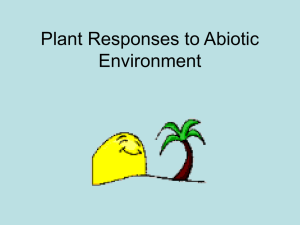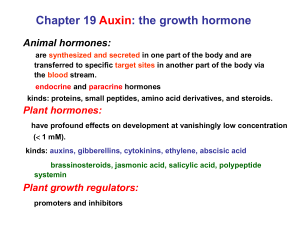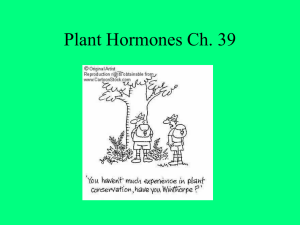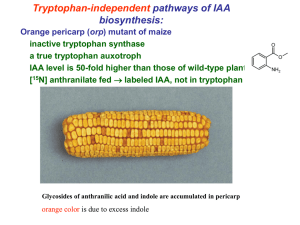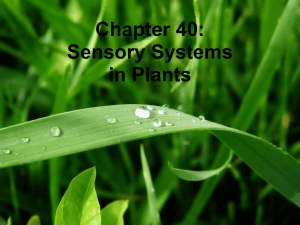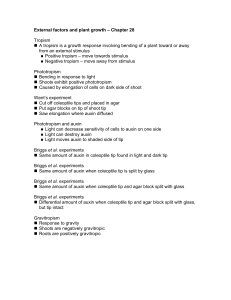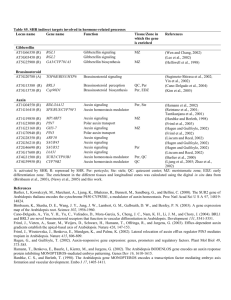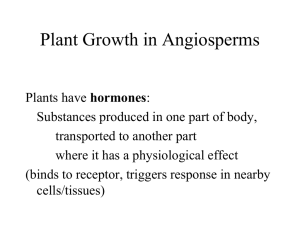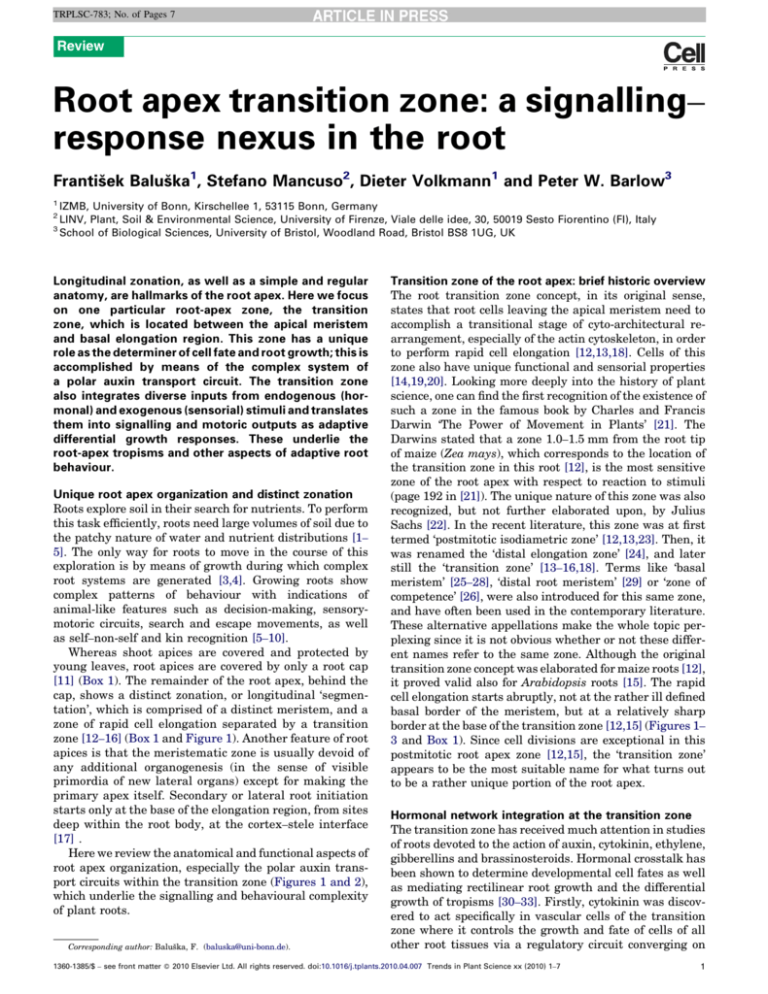
TRPLSC-783; No. of Pages 7
Review
Root apex transition zone: a signalling–
response nexus in the root
František Baluška1, Stefano Mancuso2, Dieter Volkmann1 and Peter W. Barlow3
1
IZMB, University of Bonn, Kirschellee 1, 53115 Bonn, Germany
LINV, Plant, Soil & Environmental Science, University of Firenze, Viale delle idee, 30, 50019 Sesto Fiorentino (FI), Italy
3
School of Biological Sciences, University of Bristol, Woodland Road, Bristol BS8 1UG, UK
2
Longitudinal zonation, as well as a simple and regular
anatomy, are hallmarks of the root apex. Here we focus
on one particular root-apex zone, the transition
zone, which is located between the apical meristem
and basal elongation region. This zone has a unique
role as the determiner of cell fate and root growth; this is
accomplished by means of the complex system of
a polar auxin transport circuit. The transition zone
also integrates diverse inputs from endogenous (hormonal) and exogenous (sensorial) stimuli and translates
them into signalling and motoric outputs as adaptive
differential growth responses. These underlie the
root-apex tropisms and other aspects of adaptive root
behaviour.
Unique root apex organization and distinct zonation
Roots explore soil in their search for nutrients. To perform
this task efficiently, roots need large volumes of soil due to
the patchy nature of water and nutrient distributions [1–
5]. The only way for roots to move in the course of this
exploration is by means of growth during which complex
root systems are generated [3,4]. Growing roots show
complex patterns of behaviour with indications of
animal-like features such as decision-making, sensorymotoric circuits, search and escape movements, as well
as self–non-self and kin recognition [5–10].
Whereas shoot apices are covered and protected by
young leaves, root apices are covered by only a root cap
[11] (Box 1). The remainder of the root apex, behind the
cap, shows a distinct zonation, or longitudinal ‘segmentation’, which is comprised of a distinct meristem, and a
zone of rapid cell elongation separated by a transition
zone [12–16] (Box 1 and Figure 1). Another feature of root
apices is that the meristematic zone is usually devoid of
any additional organogenesis (in the sense of visible
primordia of new lateral organs) except for making the
primary apex itself. Secondary or lateral root initiation
starts only at the base of the elongation region, from sites
deep within the root body, at the cortex–stele interface
[17] .
Here we review the anatomical and functional aspects of
root apex organization, especially the polar auxin transport circuits within the transition zone (Figures 1 and 2),
which underlie the signalling and behavioural complexity
of plant roots.
Corresponding author: Baluška, F. (baluska@uni-bonn.de).
Transition zone of the root apex: brief historic overview
The root transition zone concept, in its original sense,
states that root cells leaving the apical meristem need to
accomplish a transitional stage of cyto-architectural rearrangement, especially of the actin cytoskeleton, in order
to perform rapid cell elongation [12,13,18]. Cells of this
zone also have unique functional and sensorial properties
[14,19,20]. Looking more deeply into the history of plant
science, one can find the first recognition of the existence of
such a zone in the famous book by Charles and Francis
Darwin ‘The Power of Movement in Plants’ [21]. The
Darwins stated that a zone 1.0–1.5 mm from the root tip
of maize (Zea mays), which corresponds to the location of
the transition zone in this root [12], is the most sensitive
zone of the root apex with respect to reaction to stimuli
(page 192 in [21]). The unique nature of this zone was also
recognized, but not further elaborated upon, by Julius
Sachs [22]. In the recent literature, this zone was at first
termed ‘postmitotic isodiametric zone’ [12,13,23]. Then, it
was renamed the ‘distal elongation zone’ [24], and later
still the ‘transition zone’ [13–16,18]. Terms like ‘basal
meristem’ [25–28], ‘distal root meristem’ [29] or ‘zone of
competence’ [26], were also introduced for this same zone,
and have often been used in the contemporary literature.
These alternative appellations make the whole topic perplexing since it is not obvious whether or not these different names refer to the same zone. Although the original
transition zone concept was elaborated for maize roots [12],
it proved valid also for Arabidopsis roots [15]. The rapid
cell elongation starts abruptly, not at the rather ill defined
basal border of the meristem, but at a relatively sharp
border at the base of the transition zone [12,15] (Figures 1–
3 and Box 1). Since cell divisions are exceptional in this
postmitotic root apex zone [12,15], the ‘transition zone’
appears to be the most suitable name for what turns out
to be a rather unique portion of the root apex.
Hormonal network integration at the transition zone
The transition zone has received much attention in studies
of roots devoted to the action of auxin, cytokinin, ethylene,
gibberellins and brassinosteroids. Hormonal crosstalk has
been shown to determine developmental cell fates as well
as mediating rectilinear root growth and the differential
growth of tropisms [30–33]. Firstly, cytokinin was discovered to act specifically in vascular cells of the transition
zone where it controls the growth and fate of cells of all
other root tissues via a regulatory circuit converging on
1360-1385/$ – see front matter ß 2010 Elsevier Ltd. All rights reserved. doi:10.1016/j.tplants.2010.04.007 Trends in Plant Science xx (2010) 1–7
1
TRPLSC-783; No. of Pages 7
Review
Box 1. Root apex versus shoot apex
Besides the discussed differences in zonation, organogenesis and
transcellular auxin transport complexities, there are also other
profound differences between root and shoot apices. As all these
are interrelated, and therefore relevant for the special status of the
root apex transition zone, we list in this Box the most important
root–shoot apex differences.
1- The outer–inner polarity of the plant body [43]: the inner pole
(stele) is dominant in the root whereas the outer pole (cortex)
dominates in the shoot [43,44].
2- The inner pole (stele) reaches to the very tip of the root apex but
not to that of the shoot apex [44].
3- There is a fundamental difference in the root and shoot stem
cells. Whereas the root apex stem cells specify the three major
ground tissues of the plant body (dermal, ground and vascular
tissues), the shoot apex stem cells specify the new leaf
primordia (lateral organs).
4- Organogenesis is active at the shoot apex but absent (in the
form of visible primordia) from the root apex [44].
5- Organogenesis is peripheral at the shoot apex, initiated in the
epidermis; whereas the root organogenesis is endogenous,
initiated at the endodermis/pericycle cortex–stele boundary.
6- Endodermis controls root growth, with a major impact expressed in the transition zone [37,38].
7- Epidermis controls shoot growth at the shoot apex [41,42].
8- Cell files are very regular within the root apex, but less so within
the shoot apex [44].
9- PIN2 expression is root-apex-specific, with its maximum in the
transition zone. PIN2 is essential for tropisms of the root, but not
for those of the shoot.
10- Transition zone is very prominent in the root apex but is not
obvious in the shoot apex [40].
11- There are two bending zones in the root apex. Besides the
bending capabilities of the elongation region (present also in
the shoot apex), there is also a root-apex-specific, PIN2-based
bending in the transition zone of the root apex.
12- PIN1 and PIN7 are expressed in the epidermis of hypocotyl and
shoot apex, whereas they are expressed in the endodermis and
stele of root apex [64].
13- PINOID kinase targets PIN2 in cells of root apices [84], but it
targets PIN1 in cells of shoot apices [99,110–112].
14- The gain-of-function mutant of PINOID kinase causes collapse of
the root apex, whereas the loss-of-function mutant of PINOID
kinase causes collapse of the shoot apex [110–112].
15- Root apex has two inverted fountains of polar auxin transport
(Figure 2) converging on two different auxin signalling maxima
(BA3 and DR5) ([65], discussed in [80]).
16- Root apex is covered by a root cap, a major plant sensory organ
[44].
transcription factor SHORT HYPOCOTYL2 (SHY2)
[34,35], a member of the auxin-repressor Aux/IAA family
[36]. Cytokinin/auxin crosstalk is embedded within even
more complex hormonal networks in the transition zone
[29–33] which, in their turn, control diverse aspects of root
biology such as tropisms, behaviour and communication
[2–10,20]. Secondly, gibberellin signalling in the endodermis of the transition zone has been shown to control root
meristem size [37] via targeting the degradation of DELLA
repressor proteins (named after a highly conserved DELLA
amino-acid motif in their N-terminal domains) [38].
DELLA-dependent mechanisms are relevant also for regulating cell cycle activities in the root meristem [39] and
help define the border between the basal meristem and
distal portion of the transition zone [40]. The endodermis is
present within the transition zone and acts as major
gibberellin-responsive tissue regulating the cell expansion
necessary for root growth [32,37,38]. It is interesting to
2
Trends in Plant Science Vol.xxx No.x
note that, in shoots, the control of growth does not reside at
the endodermis but at the epidermis [41]. In this case,
brassinosteroid signalling underlies the epidermal growth
control [41,42]. This reversed outer–inner control tissue
phenomenon resembles the concept of outer–inner polarity
of the plant body with respect to hormone sensitivities
proposed by Si-Jiu Liu and Elisabeth Tillberg [43]. In this
concept, the inner pole is represented by the vascular
tissues of the central cylinder whereas the outer pole is
represented by the cortex tissues and the epidermis (Box
1). In shoots, the outer pole predominates whereas in roots
the inner pole is dominant [43,44]. In accordance with this
model, it is known that the shoot-derived auxin controls
root apices and the root-derived cytokinin controls shoot
apices [45–47].
Another important hormone with respect to cell fates
and growth control is the volatile hydrocarbon, ethylene,
which interacts with all other hormones [29,48]. Ethylene–
auxin crosstalk is relatively well understood and is
relevant for both root apex patterning and control of root
growth. Ethylene regulates root growth via its impact on
both auxin biosynthesis and polar auxin transport
[29,48,49]. Transition zone cells play a critical role in this
respect for they respond to increased ethylene levels with
an increased level of PIN2 production and a stimulation of
basipetal auxin transport [48], specifically in outer tissues
of the root apex [43]. In the elongation region, the response
to an increased ethylene level is different because cell
growth here becomes rapidly and irreversibly inhibited
[50,51].
Two coordinated bending zones drive root tropisms
Gravitropism is one of the many tropisms displayed by
growing roots in which physical as well as biological cues
operate [6,52,53]. The transition zone initiates a growth
differential between the upper and lower parts of a horizontally gravi-stimulated maize root [24]. Here, the growth
differential is not due to disparate cell growth rates but to a
shifting of the location where cells will begin passage into
and through the transition zone [13,54]. Cells on the upper
part of the root advance their passage through the transition zone into the zone of rapid cell elongation (i.e. they
spend a shorter period in the transition zone) whereas the
lower side cells are retarded in this developmental transition [13,23,54]. Importantly, the differential progression
of cells through the transition zone is independent of the
microtubular cytoskeleton [54]. Other studies have shown
that the actin cytoskeleton is also not needed [55,56] for
this differential cell growth which drives gravitropism of
roots [57,58]. Interestingly, there are two distinct growth
(bending) regions, corresponding to the transition zone and
elongation region (see the arrows in Figure 1), which drive
the differential growth of root electrotropism [59]. Root
tropisms as well as shoot tropisms, are based on polar
auxin transport affected by proteins of the PIN family, as
well as by members of the PGP/ABCB family of ABC
transporters [60–62].
PIN2 helps to distinguish root apex from shoot apex
Shoot and root apices differ in the expression of the auxin
transport-facilitator protein, PIN2 (Box 1). This protein is
TRPLSC-783; No. of Pages 7
Review
Trends in Plant Science
Vol.xxx No.x
Figure 1. Root apex zonation. Bending of the transition zone is related to vesicle recycling rate which shows a peak in this zone, as visualized by the size of BFA-induced
compartments. BFA treatment prevents this transition-zone root bending. Blue structures are nuclei, red structures represent BFA-induced compartments. Size of these
endocytic compartments [78,82] is proportional to the endocytic vesicle recycling rate (for further details see [20,50,74,75,78,79,81–83,107,109]). Arrows indicate the two
bending zones.
essential for root tropisms but not for shoot tropisms. In
root apices, PIN2 is responsible for the backward (towards
the root base) auxin flow in the epidermis and outer cortex
(in the case of maize roots), as well as for the second
inverted fountain of auxin flow at the basal border of the
transition zone (Figure 2). PIN2 is essential for gravitropism and phototropism of root apices, whereas both these
behavioural processes are performed in the absence of
Figure 2. Two inverted fountains of the polar auxin transport at the root apex. (a)
The basal ‘outside-in’ fountain, generated by concerted actions of PIN2 and PIN3,
localizes to the basal limit of the transition zone and is visualized via the BA3
construct activity [65]. (b) The apical ‘inside-out’ fountain, generated by concerted
actions of PIN1, PIN7 and PIN4, localizes to the quiescent centre and root cap
initials and is visualized via DR5 construct activity. The apical meristem is indicated
by the green bar, the transition zone by the red bar. For further details see
[15,16,29,31,33,60,61,63,65,67,75,81,94].
PIN2 in shoot apices (Figure 2 and Box 1). In the case of
root tropisms the PIN2 protein is tightly linked with the
outer-pole backward stream of auxin (Box 1).
PIN2 mutant lacks the transition zone bending
In contrast to shoot apices, where only PIN1 is expressed,
polar auxin transport in root apices is driven by activities
of five PIN proteins (PIN1–4 and PIN7), as well as by other
auxin transporters from the ABCB family, such as ABCB1,
ABCB4 and ABCB19 [28,60,61] and reviewed in [62–64] .
This complexity contrasts with the apparent simplicity and
regular anatomy of root apices [15,20]. In a root apex
growing downwards along the gravity vector, the acropetal
(towards the root apex) streams of auxin form a symmetrical fountain focusing upon the quiescent centre (Figure 2).
Then, this stream loops backwards, travelling through the
epidermis and outer cortex (in maize roots). At the basal
border of the transition zone, the basipetal auxin stream
loop reverses its direction, thus making an inverted fountain as it loops back again into the acropetal stream in the
stele [28,64] (Figure 2). Root apices differ from the shoot
apices by having two bending zones supported by two
fountains of the polar auxin streams (Box 1, and Figures
1 and 2). Interestingly, whereas the acropetal inside-out
fountain is associated with the DR5-based auxin-signalling
maximum, the basipetal transition-zone-based outside-in
fountain (Figure 2) is associated with the BA3-based auxinsignalling maximum [65]. Whereas PIN1, PIN4 and PIN7
feed into the DR5 maximum, PIN2 and PIN3 feed into the
BA3 auxin-signalling maximum (Figure 2). The symmetry
of these two ‘auxin-stream’ fountains is sensitive to
physical signals such as gravity, light, temperature,
humidity, oxygen concentration and several other stimuli
[2,6,52,53,66]. As a result of such stimulation, root apices
initiate either positive or negative tropisms, according to
the vectors, gradients and strengths of these environmental stimuli [52,53] (Box 1).
PIN3 mutant lacks the elongation region bending
Similar to PIN2, PIN3 has a unique status amongst PIN
proteins. Whereas all other PINs drive the auxin streams
along the axes of plant organs, PIN2 and PIN3 are responsible for lateral auxin flows within both the statocytes of
the root cap [64,67] and the cells of epidermis and cortex
3
TRPLSC-783; No. of Pages 7
Review
Trends in Plant Science Vol.xxx No.x
Figure 3. Subcellular zone-specific PIN2 targeting via endosomes in cortical cells. Apical targeting of PIN2 molecules (red structures) via the GNOM-based endosomes, and
basal targeting via the SNX1-based endosomes which control the subcellular fate of recycling PIN2 molecules in cells of the meristem and the transition zone (for details see
[95–106,110–112]). D’orenone specifically affects PIN2 in these two zones [73]: PIN2 is degraded in vacuoles in cells of the meristem and stimulated (higher gene expression
and more PIN2 molecules) at the basal-end portion of the plasma membrane in cells of the transition zone (for further details see [73]).
(PIN2) as well as the endodermis/pericycle of the transition
zone (PIN3) [28,35,60,67,68] (Figure 2). In fact, PIN3 is
expressed in the endodermis (see Box 1) throughout the
plant body and effects lateral auxin transport into the stele
[63,69]. This endogenous lateral auxin flow is joined by the
sensorially-induced lateral auxin flow resulting from
either gravi-stimulation or light-stimulation and thereby
initiates organ tropisms [63,69,70]. While the production
or expression of PIN2 is downregulated at the basal border
of the transition zone, the expression of PIN1, PIN3 and
PIN7 continues throughout the elongation region (see the
Figure 2 in [71]). Importantly, a recent study of a pin3
mutant line revealed that, although it has normal root
bending in the transition zone, it failed to bend in the
elongation region [68]. Obviously, the lateral auxin transport supported by PIN3 is essential for the differential
growth in this second root-bending zone in the elongation
region (Figure 1) but is not required for the bending at the
transition zone [72,73]. pin2 roots are almost insensitive to
ethylene [72]; however, although they fail to respond to
internally generated auxin, they respond normally to
externally applied auxin [72].
The transition zone is the most active zone with respect
to auxin flux
In order to understand in vivo auxin transport, a crucial
technique is one which monitors auxin fluxes in real time.
To achieve this, auxin fluxes were monitored within
intact plant organs using non-invasive carbon nanotube-modified and self-referencing, auxin-specific microelectrodes [74]. A surprising result was the finding of a
peak of auxin flux in the distal portion of the transition
4
zone, which, in large maize root apices, extends over the
distance of 0.9–1.8 mm from the root tip [74]. These cells
show fluxes significantly higher than those in the more
apical cells of the root cap and root meristem, or in the
more basal cells of the elongation region (see the Figure 3
in [74]). A similar pattern of auxin flux has been
measured also for roots of Arabidopsis [75–77]. All this
suggests that, in both dicots and monocots, this distinct
peak of auxin flow is inherently related to cellular and
subcellular processes specific to the distal portion of the
transition zone.
Transcellular auxin transport in the transition zone is
driven by vesicle recycling
The peak in auxin flux is very sensitive not only to the
classical inhibitors of polar auxin transport such as N-1naphthylphthalamic acid (NPA) and 2,3,5-triiodobenzoic
acid (TIBA), but also to brefeldin A (BFA; Figure 3 in [74]).
All these inhibitors affect auxin flux via an inhibition of
vesicle trafficking [78,79]. This indicates that PIN proteins
support auxin flux via vesicular secretion of auxin based on
the endocytic vesicle recycling. Immunolocalization of
auxin in maize root cells confirms auxin enrichment in
the endosomes that participate in polar auxin transport
[80]. In further support of this neurotransmitter-like mode
(i.e. secretion via endocytic vesicle recycling) of auxin
transport by cells of the transition zone [81], is the very
close correlation between the rate of vesicle recycling and
the auxin flux in the transition zone [82–84] (Figure 1).
However, there is no clear correlation between the number
of PIN molecules at the plasma membrane and the auxin
flux [80,83,84].
TRPLSC-783; No. of Pages 7
Review
Vesicle recycling peak corresponds with peaks of auxin
flux and electrical activity
Studies devoted to expression and activities of phospholipase Dz2 (PLDz2), which produces the second messenger, phosphatidic acid (PA), revealed that Arabidopsis
PLDz2 regulates vesicle trafficking and is required for
an auxin response [85–87]. Interestingly, PLDz2 (and
PLDz1) is different from the other 10 PLDs in Arabidopsis
in that it resembles mammalian PLDs with respect to its
PX and PH domains; moreover, it is strongly expressed in
roots, especially in transition zone cells [75,85,88]. Overexpression of PLDz2, as well as the addition of PA, stimulates vesicle recycling and auxin transport in the
transition zone [75]. Here, the peak in the polar auxin
transport is based on the high rate of BFA-sensitive endocytic vesicle recycling, supporting the neurotransmitter
secretion model for auxin transport [75,85,87] (Box 1).
Furthermore, a pldzeta2 mutant [75,85,88] shows inhibited auxin secretion in the transition zone, and the pldzeta
phenotype can be mimicked following exposure to the
general PLD activity inhibitor, 1-butanol [75]. Importantly, PLDz2 is expressed specifically in cells of the
transition zone [75,85].
Besides being a site of a high rate of endocytosis-based
vesicle recycling, which in some obscure way is linked to
the auxin transport peak, the transition zone of the root
apex shows exceptional behaviour regarding electrical
activity. Using a 60-channels multielectrode array
(MEA), spatiotemporal characteristics of the electrical
network activity of the maize root apex were analyzed
[89]. Data obtained by this means revealed synchronous
and oscillatory electric activity in the transition zone
only, supporting the concept that this zone of the root
serves some, so-far unknown, but apparently specific
purpose for the integration of internal and external
signalling. Interestingly, these cells are also very effective in supporting coherent transcellular calcium waves
spanning the whole root apex after mechano-stimulation
(see Figure 3d in [90]) and in the touch-induced ATP
release from cells into extracellular space [91]. These
phenomena are relevant for cell–cell signalling and
obstacle-avoidance behaviour of growing root apices
[90,91].
Unique nature of PIN2 polarity in the transition zone
The PIN2 protein does not belong to any of the multiple
PIN subclasses: one subclass encompasses PIN1, PIN3,
PIN4 and PIN7, whereas a second subclass contains
PIN5, PIN6 and PIN8 [92]. PIN2 is unique amongst PINs
in supporting basipetal (against the gravity vector) transport of auxin. In the pin2 mutant line, PIN1 can partially
replace PIN2 [93,94]. PIN2 undergoes a shift in its intracellular localization in root cortex cells; mitotic cells
target PIN2 acropetally, whereas the transition zone
cells, and the cells of epidermis, target it basipetally
[95] (Figure 3). Recent reports indicate that PIN2 is
targeted to the apical (facing the root apex) pole of the
cell via the GNOM-based endosomal recycling pathway,
whereas sorting nexin 1 (SNX1) endosomes link PIN2
polarization to the opposite basal pole of the cell [96–99]
(Figure 3).
Trends in Plant Science
Vol.xxx No.x
PIN2 is a general stress target and underlies avoidance
and escape tropisms of roots
Mutant roots devoid of PIN2 are not only inferior in their
gravitropic and phototropic responses, but they are also
extremely sensitive to diverse environmental cues and
stress situations. Firstly, PIN2 rapidly associates with
endosomal compartments in cells at the lower, slowly
expanding part of gravi-stimulated root apices [100].
SNX1 emerges as a marker of these elusive endosomes
responsible for control of localization and fate of PIN2, at
least in cells of root apices [101–103]. Enrichment of PIN2
in these endosomes is also a feature of all cells in the
transition zone when roots are kept in darkness [104] –
the normal situation of plant roots growing in their natural
soil habitat. Next, PIN2 is targeted into endomembrane
compartments and is selectively degraded in salt-stressed
root cells [105]. The functional disassembly of this gravisensitive network based on PIN2 allows roots to deviate
from the gravity vector and to accomplish salt-stress avoidance tropism [106]. A similar situation, when PIN2 is
rapidly degraded in cells of the meristem, was reported
for Arabidopsis roots exposed to D’orenone, an early cleavage product of b-carotene en route to trisporic acids [73]
(Figure 3).
Transition zone PIN2 emerges as the aluminiumtoxicity target of root apices [83,107]. Intriguingly, in this
stress situation, PIN2 endocytosis is inhibited [105]. As a
result of this, the amount of PIN2 at the plasma membrane
was increased, whereas PIN2 was depleted from the endosomes [83]. Similarly, cold-stress inhibited recycling of
PIN2, and of PIN3 also, and kept almost all PIN2 molecules at the plasma membrane [108]. Cells of the transition zone are also unique with respect to both PHOT1based sensing of blue light and the negative phototropism
of root apices [109]. Illuminated roots grow quicker and
perform enhanced vesicular recycling of both PIN1 and
PIN2 [104]. This response has been proposed to constitute
a new kind of root tropism – the light-escape tropism [66].
Conclusions
The transition zone of root apices is a unique part of the
whole plant body. Apart from tip-growing cells, such as root
hairs and pollen tubes, the cells of the transition zone have
the highest rate of vesicle recycling activity, and their
auxin transport shows the highest degree of activity. In
this root apex zone, auxin is secreted across the recycling
and F-actin–myosin VIII-based cell–cell adhesion domains
in a neurotransmitter-like fashion [81] which is driven by
PLDz2 activity [75]. This is the only zone in the whole plant
body for which synchronized electrical activity has been
reported [89]. The activity of auxin-secreting domains of
the transition zone is sensitive not only to internal developmental cues but, importantly, also to environmental
inputs such as light and gravity. The transition zone
integrates the sensory-motoric circuits, allowing diverse
root tropisms. Importantly, the natural environment for
roots is darkness, and illumination of Arabidopsis roots
activates a light-escape tropism [66]. Consequently, conclusions reached from numerous already published in vivo
data obtained using illuminated roots may require fundamental re-interpretations.
5
TRPLSC-783; No. of Pages 7
Review
References
1 Dittmer, H.J. (1937) A quantitative study of the roots and root hairs of
a winter rye plant (Secale cereale). Am. J. Bot. 24, 417–420
2 Monshausen, G.B. and Gilroy, S. (2009) The exploring root – root
growth responses to local environmental conditions. Curr. Opin. Plant
Biol. 12, 766–772
3 Nibau, C. et al. (2008) Branching out in new directions: the control of
root architecture by lateral root formation. New Phytol. 179, 595–614
4 López-Bucio, J. et al. (2003) The role of nutrient availability in
regulating root architecture. Curr. Opin. Plant Biol. 6, 280–287
5 Desnos, T. (2008) Root branching responses to phosphate and nitrate.
Curr. Opin. Plant Biol. 11, 82–87
6 Hodges, A. (2009) Root decisions. Plant Cell Environ. 32, 628–640
7 Trewavas, A. (2009) What is plant behavior? Plant Cell Environ. 32,
606–616
8 Trewavas, A. (2004) Aspects of plant intelligence: an answer to Firn.
Ann. Bot. 93, 353–357
9 Gruntman, M. and Novoplansky, A. (2004) Physiologically mediated
self/non-self discrimination in roots. Proc. Natl. Acad. Sci. U. S. A. 101,
3863–3867
10 Biedrzycki, M.L. et al. (2010) Root exudates mediate kin recognition in
plants. Commun. Integr. Biol. 3, 28–35
11 Barlow, P.W. (2003) The root cap: cell dynamics, cell differentiation
and cap function. J. Plant Growth Regul. 21, 261–286
12 Baluška, F. et al. (1990) Postmitotic ‘isodiametric’ cell growth in the
maize root apex. Planta 181, 269–274
13 Baluška, F. et al. (1996) Specialized zones of development in roots:
view from the cellular level. Plant Physiol. 112, 3–4
14 Baluška, F. et al. (2001) A polarity crossroad in the transition growth
zone of maize root apices: cytoskeletal and developmental
implications. J. Plant Growth Regul. 20, 170–181
15 Verbelen, J-P. et al. (2006) The root apex of Arabidopsis thaliana
consists of four distinct zones of cellular activities: meristematic zone,
transition zone, fast elongation zone, and growth terminating zone.
Plant Signal. Behav. 1, 296–304
16 Kieffer, M. et al. (2009) Defining auxin response contexts in plant
development. Curr. Opin. Plant Biol. 13, 12–20
17 Péret, B. et al. (2009) Lateral root emergence: a difficult birth. J. Exp.
Bot. 60, 3637–3643
18 Baluška, F. et al. (1997) Rearrangements of F-actin arrays in growing
cells of intact maize root apex tissues: a major developmental switch
occurs in the postmitotic transition region. Eur. J. Cell Biol. 72, 113–
121
19 Baluška, F. et al. (2004) Root apices as plant command centres: the
unique ‘brain-like’ status of the root apex transition zone. Biologia 59,
9–17
20 Baluška, F. et al. (2009) Intracellular domains and polarity in root
apices: from synaptic domains to plant neurobiology. Nova Acta
Leopold. 96, 103–122
21 Darwin, C.R. (assisted by Darwin, F.) (1880) The Power of Movement
in Plants, John Murray (http://darwin-online.org.uk/)
22 Verbelen, J.P. and Vissenberg, K. (2006) Cell expansion: past, present
and perspectives. In The Expanding Cell (Verbelen J.P. and
Vissenberg K., eds). Plant Cell Monographs (Vol 5), pp. 1–6,
Springer-Verlag.
23 Ishikawa, H. and Evans, M.L. (1992) Induction of curvature in maize
roots by calcium or by thigmostimulation: role of the postmitotic
isodiametric growth zone. Plant Physiol. 100, 762–768
24 Ishikawa, H. and Evans, M.L. (1993) The role of the distal elongation
zone in the response of maize roots to auxin and gravity. Plant Physiol.
102, 1203–1210
25 De Smet, I. et al. (2007) Auxin-dependent regulation of lateral root
positioning in the basal meristem of Arabidopsis. Development 134,
681–690
26 De Smet, I. and Juergens, G. (2007) Patterning the axis in plants –
auxin in control. Curr. Opin. Genet. Dev. 17, 337–343
27 Peret, B. et al. (2009) Arabidopsis lateral root development: an
emerging story. Trends Plant Sci. 14, 399–408
28 Nieuwland, J. et al. (2009) The D-type cyclin CYCD4;1 modulates
lateral root density in Arabidopsis by affecting the basal meristem
region. Proc. Natl. Acad. Sci. U. S. A. 106, 22528–22533
29 Blilou, I. et al. (2005) The PIN auxin efflux facilitator network controls
growth and patterning in Arabidopsis roots. Nature 433, 39–44
6
Trends in Plant Science Vol.xxx No.x
30 Benková, E. and Hejátko, J. (2009) Hormone interactions at the root
apical meristem. Plant Mol. Biol. 69, 383–396
31 Moubayidin, L. et al. (2009) Cytokinin-auxin crosstalk. Trends Plant
Sci. 14, 557–562
32 Wolters, H. and Jürgens, G. (2009) Survival of the flexible: hormonal
growth control and adaptation in plant development. Nat. Rev. Genet.
10, 305–317
33 Doerner P (2009) Plant meristems: cytokinins – alpha and omega of
the meristem. Curr. Biol. 17, R321–R323
34 Dello Ioio, R. et al. (2007) Cytokinins determine Arabidopsis root
meristem size by controlling cell differentiation. Curr. Biol. 17, 678–
682
35 Dello Ioio, R. et al. (2007) A genetic framework for the control of cell
division and differentiation in the root meristem. Science 322, 1380–
1384
36 Tian, Q. and Reed, J.W. (1999) Control of auxin-regulated root
development by the Arabidopsis thaliana SHY2/IAA3 gene.
Development 126, 711–721
37 Ubeda-Tomás, S. et al. (2009) Gibberellin signaling in the endodermis
controls Arabidopsis root meristem size. Curr. Biol. 19, 1194–1199
38 Ubeda-Tomás, S. et al. (2008) Root growth in Arabidopsis requires
gibberellin/DELLA signalling in the endodermis. Nat. Cell Biol. 10,
625–628
39 Achard, P. et al. (2009) Gibberellin signaling controls cell proliferation
rate in Arabidopsis. Curr. Biol. 19, 1188–1193
40 Jacobs, T. (1997) Why do plant cells divide? Plant Cell 9, 1021–1029
41 Savaldi-Goldstein, S. et al. (2007) The epidermis both drives and
restricts plant shoot growth. Nature 446, 199–202
42 Scheres, B. (2007) The force from without. Nature 446, 151–152
43 Liu, S.J. and Tillberg, E. (1984) Sensitivity to phytohormones
determined by outer-inner polarity of higher plants. An overall
model for phytohormone actions. Plant Cell Environ. 7, 75–80
44 Baluška, F. et al. (2006) Neurobiological view of plants and their body
plan. In Communication in Plants: Neuronal Aspects of Plant Life
(Baluška, F. et al., eds), pp. 19–35, Springer-Verlag
45 Bhalerao, R.P. et al. (2002) Shoot-derived auxin is essential for early
lateral root emergence in Arabidopsis seedlings. Plant J. 29, 325–332
46 Fu, X. and Harberd, N.P. (2003) Auxin promotes Arabidopsis root
growth by modulating gibberellin response. Nature 421, 740–743
47 Kyozuka, J. (2007) Control of shoot and root meristem function by
cytokinin. Curr. Opin. Plant Biol. 10, 442–446
48 Růžička, K. et al. (2007) Ethylene regulates root growth through
effects on auxin biosynthesis and transport-dependent auxin
distribution. Plant Cell 19, 2197–2212
49 Swarup, R. et al. (2007) Ethylene upregulates auxin biosynthesis in
Arabidopsis seedlings to enhance inhibition of root cell elongation.
Plant Cell 19, 2186–2196
50 Le, J. et al. (2001) In the early response of Arabidopsis roots to
ethylene, cell elongation is up- and down-regulated and uncoupled
from differentiation. Plant Physiol. 125, 519–522
51 De Cnodder, T. et al. (2005) Regulation of cell length in the
Arabidopsis thaliana root by the ethylene precursor 1aminocyclopropane-1-carboxylic acid: a matter of apoplastic
reactions. New Phytol. 168, 541–550
52 Gilroy, S. (2008) Plant tropisms. Curr. Biol. 18, R275–R277
53 Cassab, G. (2008) Other tropisms and their relationship to
gravitropism. In Plant Tropisms (Gilroy, S. and Masson, P.H.,
eds), pp. 123–139, Blackwell Publishing Ltd
54 Baluška, F. et al. (1996) Gravitropism of the primary root of maize: a
complex pattern of differential cellular growth in the cortex
independent of the microtubular cytoskeleton. Planta 197, 310–318
55 Staves, M.P. et al. (1997) Cytochalasin D does not inhibit gravitropism
in roots. Am. J. Bot. 84, 1530–1535
56 Mancuso, S. et al. (2006) Actin turnover-mediated gravity response in
maize root apices: gravitropism of decapped roots implicates
gravisensing outside of the root cap. Plant Signal. Behav. 1, 52–58
57 Evans, M.L. and Ishikawa, H. (1997) Cellular specificity of the
gravitropic motor response in roots. Planta 203 (Suppl 1), S115–S122
58 Wolverton, C. et al. (2002) The kinetics of root gravitropism: dual
motors and sensors. J. Plant Growth Regul. 21, 102–112
59 Wolverton, C. et al. (2000) Two distinct regions of response drive
differential growth in Vigna root electrotropism. Plant Cell Environ.
23, 1275–1280
TRPLSC-783; No. of Pages 7
Review
60 Lewis, D.R. et al. (2007) Separating the roles of acropetal and
basipetal auxin transport on gravitropism with mutations in two
Arabidopsis Multidrug Resistance-Like ABC transporter genes.
Plant Cell 19, 1838–1850
61 Mravec, J. et al. (2008) Interaction of PIN and PGP transport
mechanisms in auxin distribution-dependent development.
Development 135, 3345–3354
62 Bandyopadhyay, A. et al. (2007) Interactions of PIN and PGP auxin
transport mechanisms. Biochem. Soc. Trans. 35, 137–141
63 Friml, J. et al. (2002) Lateral relocation of auxin efflux regulator PIN3
mediates tropism in Arabidopsis. Nature 415, 806–809
64 Petrášek, J. and Friml, J. (2009) Auxin transport routes in plant
development. Development 136, 2675–2688
65 Oono, Y. et al. (1998) age mutants of Arabidopsis exhibit altered
auxin-regulated gene expression. Plant Cell 10, 1649–1662
66 Baluška, F. et al. (2009) The ‘root-brain’ hypothesis of Charles and
Francis Darwin: revival after more than 125 years. Plant Signal.
Behav. 4, 1121–1127
67 Harrison, B.R. and Masson, P.H. (2008) ARL2, ARG1 and PIN3 define
a gravity signal transduction pathway in root statocytes. Plant J. 53,
380–392
68 Chavarrı́a-Krauser, A. et al. (2008) Spatio-temporal quantification of
differential growth processes in root growth zones based on a novel
combination of image sequence processing and refined concepts
describing curvature production. New Phytol. 177, 811–821
69 Moore, I. (2002) Gravitropism: lateral thinking in auxin transport.
Curr. Biol. 12, R452–R454
70 Blakeslee, J.J. et al. (2004) Relocalization of the PIN1 auxin efflux
facilitator plays a role in phototropic responses. Plant Physiol. 134,
28–31
71 Laskowski, L. et al. (2008) Root system architecture from coupling cell
shape to auxin transport. PLoS Biol. 6, e307
72 Luschnig, C. et al. (1998) EIR1, a root-specific protein involved in
auxin transport, is required for gravitropism in Arabidopsis thaliana.
Genes Dev. 12, 2175–2187
73 Schlicht, M. et al. (2008) D’orenone blocks polarized tip-growth of root
hairs by interfering with the PIN2-mediated auxin transport network
in the root apex. Plant J. 55, 709–717
74 Mancuso, S. et al. (2005) Non-invasive and continuous recordings of
auxin fluxes in intact root apex with a carbon-nanotube-modified and
self-referencing microelectrode. Anal. Biochem. 341, 344–351
75 Mancuso, S. et al. (2007) Phospholipase Dz2 drives vesicular secretion
of auxin for its polar cell-cell transport in the transition zone of the
root apex. Plant Signal. Behav. 2, 240–244
76 Bouchard, R. et al. (2006) Immunophilin-like TWISTED DWARF1
modulates auxin efflux activities of Arabidopsis P-glycoproteins. J.
Biol. Chem. 281, 30603–30612
77 Bailly, A. et al. (2008) Modulation of P-glycoproteins by auxin
transport
inhibitors
is
mediated
by
interaction
with
immunophilins. J. Biol. Chem. 283, 21817–21826
78 Geldner, N. et al. (2001) Auxin transport inhibitors block PIN1 cycling
and vesicle trafficking. Nature 413, 425–428
79 Dhonukshe, P. et al. (2008) Auxin transport inhibitors impair vesicle
motility and actin cytoskeleton dynamics in diverse eukaryotes. Proc.
Natl. Acad. Sci. U. S. A. 105, 4489–4494
80 Schlicht, M. et al. (2006) Auxin immunolocalization implicates
vesicular neurotransmitter-like mode of polar auxin transport in
root apices. Plant Signal. Behav. 1, 122–133
81 Baluška, F. et al. (2003) Polar transport of auxin: carrier-mediated
flux across the plasma membrane or neurotransmitter-like secretion?
Trends Cell Biol. 13, 282–285
82 Baluška, F. et al. (2008) F-actin-dependent endocytosis of cell wall
pectins in meristematic root cells: insights from brefeldin A-induced
compartments. Plant Physiol. 130, 422–431
83 Shen, H. et al. (2008) Aluminium toxicity targets PIN2 in Arabidopsis
root apices: effects on PIN2 endocytosis, vesicular recycling, and polar
auxin transport. Chin. Sci. Bull. 53, 2480–2487
84 Sukumar, P. et al. (2009) PINOID kinase regulates root gravitropism
through modulation of PIN2-dependent basipetal auxin transport in
Arabidopsis. Plant Physiol. 150, 722–735
85 Li, G. and Xue, H.W. (2007) Arabidopsis PLDz2 regulates
vesicle trafficking and is required for auxin response. Plant Cell
19, 281–295
Trends in Plant Science
Vol.xxx No.x
86 Xue, H. et al. (2007) Involvement of phospholipid signaling in plant
growth and hormone effects. Curr. Opin. Plant Biol. 10, 483–489
87 Yang, X. et al. (2008) Membrane Steroid Binding Protein 1 (MSBP1)
stimulates tropism by regulating vesicle trafficking and auxin
redistribution. Mol. Plant. 1, 1077–1087
88 Li, M. et al. (2006) Double knockouts of phospholipases Dz1 and Dz2 in
Arabidopsis affect root elongation during phosphate-limited growth
but do not affect root hair patterning. Plant Physiol. 140, 761–770
89 Masi, E. et al. (2009) Spatio-temporal dynamics of the electrical
network activity in the root apex. Proc. Natl. Acad. Sci. U. S. A.
106, 4048–4053
90 Fasano, J.M. et al. (2002) Ionic signaling in plant responses to gravity
and touch. J. Plant Growth Regul. 21, 71–88
91 Weerasinghe, R.R. et al. (2009) Touch induces ATP release in
Arabidopsis roots that is modulated by the heterotrimeric Gprotein complex. FEBS Lett. 583, 2521–2526
92 Mravec, J. et al. (2009) Subcellular homeostasis of phytohormone
auxin is mediated by the ER-localized PIN5 transporter. Nature 459,
1136–1140
93 Vieten, A. et al. (2005) Functional redundancy of PIN proteins is
accompanied by auxin-dependent cross-regulation of PIN expression.
Development 132, 4521–4531
94 Santelia, D. et al. (2008) Flavonoids redirect PIN-mediated polar
auxin fluxes during root gravitropic responses. J. Biol. Chem. 283,
31218–31226
95 Chen, R. and Masson, P.H. (2006) Auxin transport and recycling of
PIN proteins in plants. In Plant Endocytosis (Šamaj, J. et al., eds), pp.
139–157, Springer-Verlag
96 Kleine-Vehn, J. et al. (2008) ARF GEF-dependent transcytosis and
polar delivery of PIN auxin carriers in Arabidopsis. Curr. Biol. 18,
526–531
97 Kleine-Vehn, J. et al. (2008) Differential degradation of PIN2 auxin
efflux carrier by retromer-dependent vacuolar targeting. Proc. Natl.
Acad. Sci. U. S. A. 105, 17812–17817
98 Kleine-Vehn, J. et al. (2008) Cellular and molecular requirements for
polar PIN targeting and transcytosis in plants. Mol. Plant 1, 1056–1066
99 Kleine-Vehn, J. et al. (2009) PIN auxin efflux carrier polarity is
regulated by PINOID kinase-mediated recruitment into GNOMindependent trafficking in Arabidopsis. Plant Cell 21, 3839–3849
100 Abas, L. et al. (2006) Intracellular trafficking and proteolysis of the
Arabidopsis auxin-efflux facilitator PIN2 are involved in root
gravitropism. Nat. Cell Biol. 8, 249–256
101 Jaillais, Y. et al. (2006) AtSNX1 defines an endosome for auxin-carrier
trafficking in Arabidopsis. Nature 443, 106–109
102 Jaillais, Y. et al. (2007) Sorting out the sorting functions of endosomes
in Arabidopsis. Plant Signal. Behav. 2, 556–558
103 Jaillais, Y. et al. (2008) Evidence for a sorting endosome in
Arabidopsis root cells. Plant J. 53, 237–247
104 Laxmi, A. et al. (2008) Light plays an essential role in intracellular
distribution of auxin efflux carrier PIN2 in Arabidopsis thaliana.
PLoS One 3, e1510
105 Sun, F. et al. (2008) Salt modulates gravity signaling pathway to
regulate growth direction of primary roots in Arabidopsis. Plant
Physiol. 146, 178–188
106 Li, X. and Zhang, W.S. (2008) Salt-avoidance tropism in Arabidopsis
thaliana. Plant Signal. Behav. 3, 351–353
107 Illés, P. et al. (2006) Aluminium toxicity in plants: internalisation
of aluminium into cells of the transition zone in Arabidopsis root
apices relates to changes in plasma membrane potential, endosomal
behaviour, and nitric oxide production. J. Exp. Bot. 57, 4201–4213
108 Shibasaki, K. et al. (2009) Auxin response in Arabidopsis under cold
stress: underlying molecular mechanisms. Plant Cell 21, 3823–3838
109 Wan, F. et al. (2008) The subcellular localization and blue-lightinduced movement of phototropin 1-GFP in etiolated seedlings of
Arabidopsis thaliana. Mol. Plant 1, 103–117
110 Friml, J. et al. (2004) A PINOID-dependent binary switch in apicalbasal PIN polar targeting directs auxin efflux. Science 306, 862–865
111 Michniewicz, M. et al. (2007) Antagonistic regulation of PIN
phosphorylation by PP2A and PINOID directs auxin flux. Cell 130,
1044–1056
112 Huang, F. et al. (2010) Phosphorylation of conserved PIN motifs
directs Arabidopsis PIN1 polarity and auxin transport. Plant Cell
22, (in press), doi:10.1105/tpc.109.072678
7

